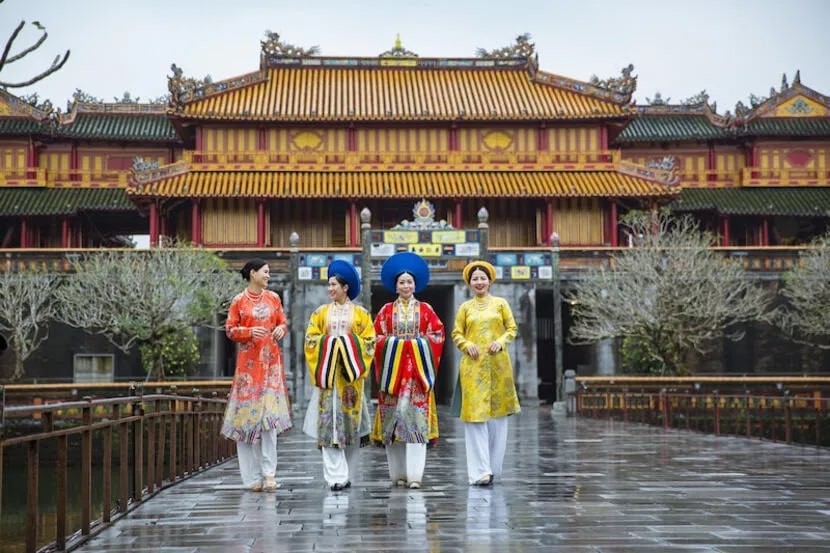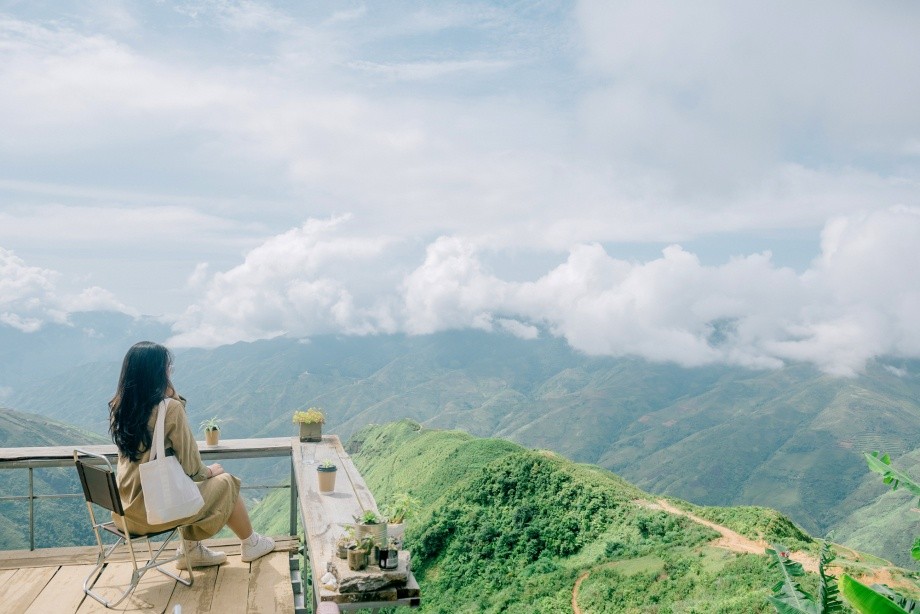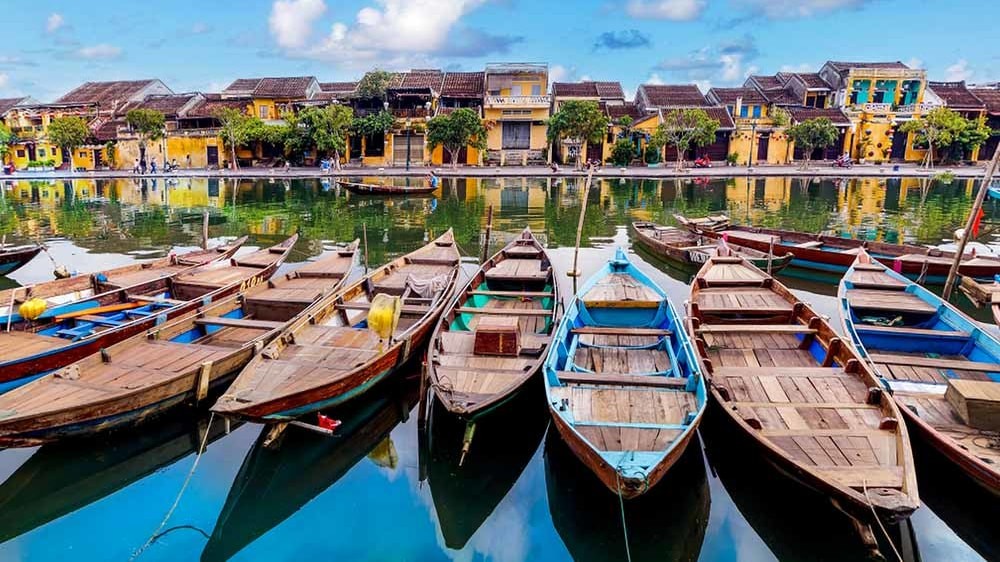Top 10 Largest Temples In The World
Temple is a very religious place for any religion and it elevates the meaning of spiritualism. There are a large number of temples around the world which were built during since ages. In fact, archeologists find many evidences of existence of temples since pre-historic era. Each of them have something different in their architecture.
According to the Guinness World Record the Akshardham Temple is the largest Hindu temple in the world but this is disputed by at least 3 other temples in India which are all claimed to be the largest temple. These temples are often part of a larger complex which makes it even less clear. Here is top 10 largest temples in the world.
1. Baalbek, Lebannon
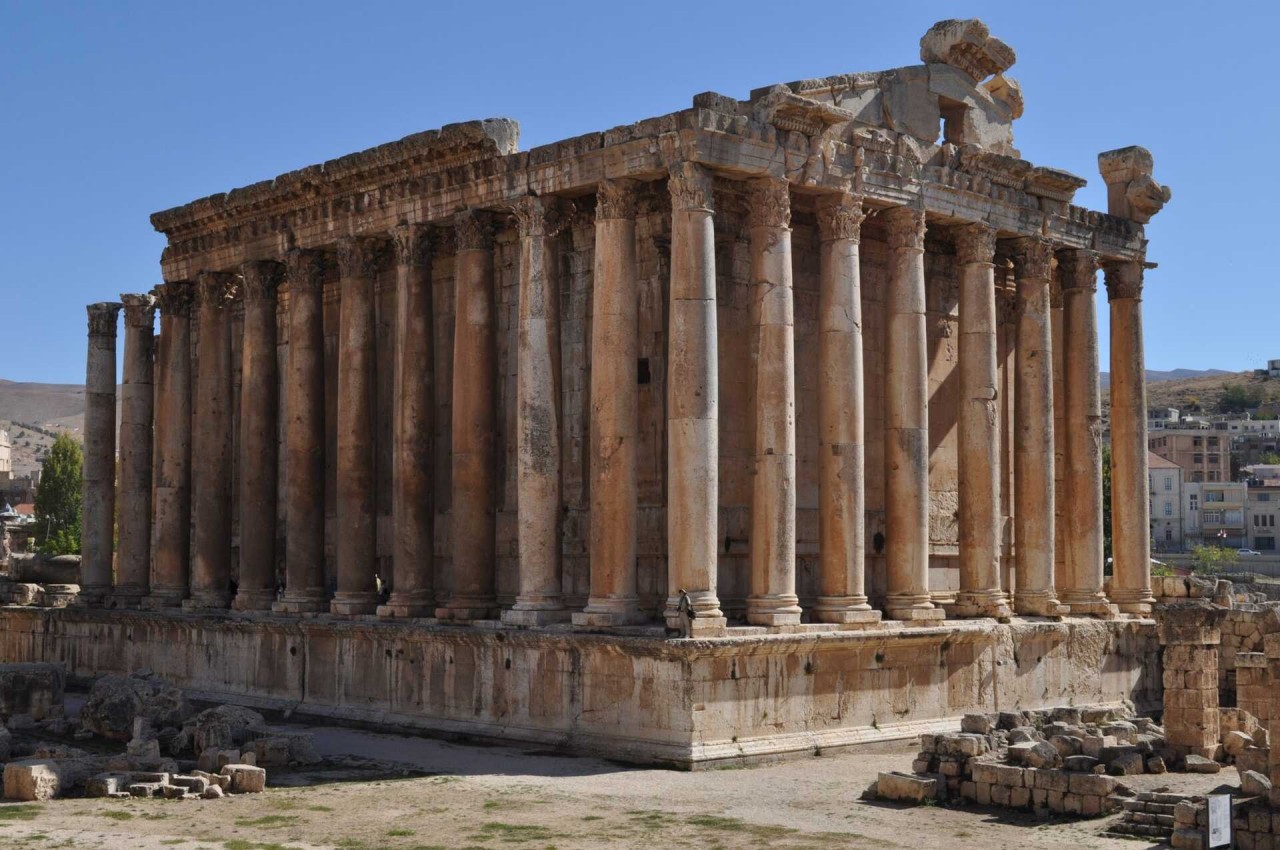 |
| Photo: Agriculture Foundation of Santa Barbara |
Baalbek, Lebanon, is the site of one of the most mysterious ruins of the Roman Empire, a monumental two-thousand-year-old temple to Jupiter that sits atop three thousand-ton stone blocks. (The pillars of Stonehenge weigh about a fortieth of that.) The blocks originated in a nearby limestone quarry, where a team from the German Archaeological Institute, in partnership with Jeanine Abdul Massih, of Lebanese University, recently discovered what they are calling the largest stone block from antiquity, weighing one thousand six hundred and fifty tons and matching those that support the temple. Its provenance is more shadowy than one might expect of a three-million-pound megalith. Nobody seems to know on whose orders it was cut, or why, or how it came to be abandoned.
Baalbek is named for Baal, the Phoenician deity, although the Romans knew the site by its Greek name, Heliopolis. The historian Dell Upton has noted the unusual lack of documentation regarding who might have commissioned, paid for, or designed the temple. For Upton, the site is a metaphor for the role of imaginative distortion in architectural history. In the absence of concrete information, he writes, Baalbek has become “a very accommodating screen upon which to project strikingly varied stories.” There are many local legends about the origin of the temple: Cain built it to hide from the wrath of God; giants built it, at Nimrod’s command, and it came to be called the Tower of Babel; Solomon built it, with djinns’ assistance, as a palace for the Queen of Sheba. (It is said that the reason some blocks were left in the quarry is that the djinns went on strike.)
Testimony to Baalbek’s flummoxing properties can be found in the 1860 diary of the Scottish traveller David Urquhart, whose mental capacities were “paralyzed” by “the impossibility of any solution.” Urquhart devotes several pages to the “riddles” posed by the giant stones—“so enormous, as to shut out every other thought, and yet to fill the mind only with trouble.” What, for example, was the point of cutting such enormous rocks? And why do it out there in the middle of nowhere, instead of in a capital or a port? Why were there no other sites that looked like Baalbek? And why had the work been abandoned midway? Urquhart concludes that the temple must have been built by contemporaries of Noah, using the same technological prowess that enabled the construction of the ark. Work was halted because of the flood, which swept away all the similar sites, leaving the enigma of Baalbek alone on the face of the earth.
2. Cathedral of Christ the Saviour
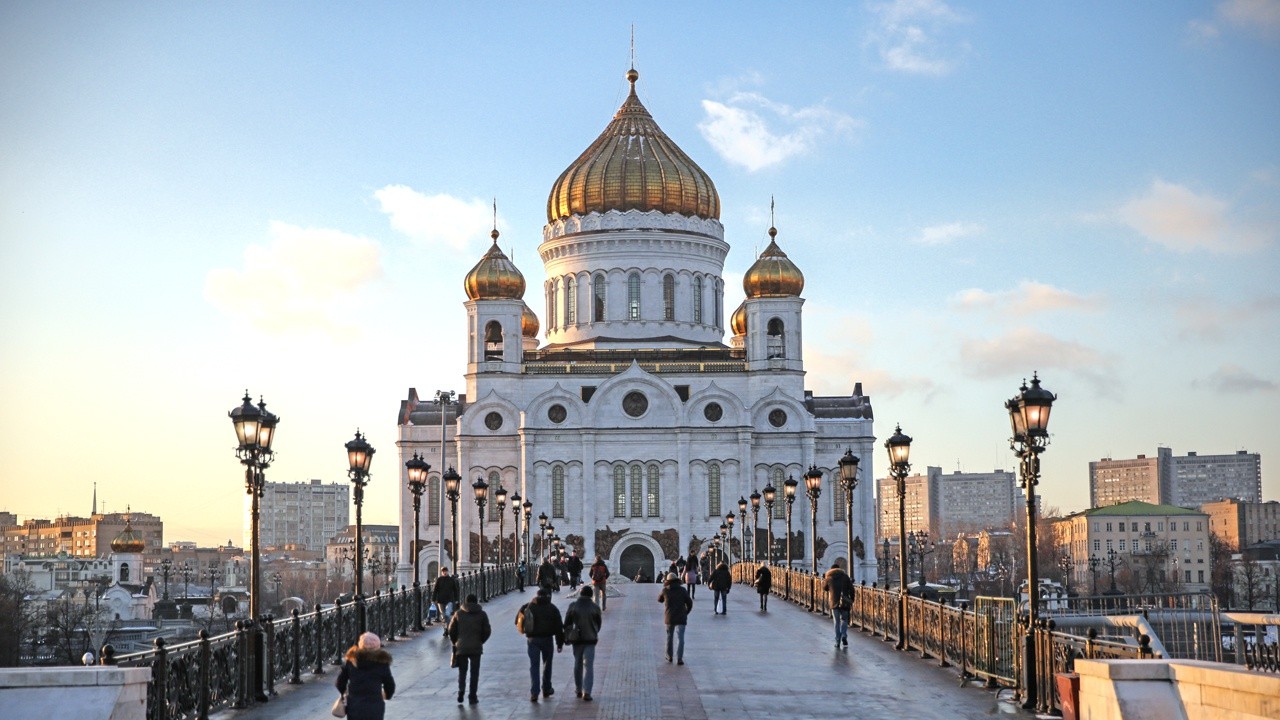 |
| Photo: Russia Beyond |
The Cathedral of Christ the Saviour of Moscow was originally built between 1839 and 1883, commissioned by Tsar Alexander I in honour of those who died in the Patriotic War of 1812. Its design was based on the Hagia Sophia in Constantinople, present-day Istanbul.
After the Bolshevik Revolution of 1917, the cathedral fell victim to the state's anti-religious campaign, and it was demolished in 1931. Stalin's plans to use the plot to build the tallest skyscraper in the world failed due to a lack of funding and the German invasion during World War II, but eventually the land found a new use. The largest swimming pool in the world, heated so it could be used all year round, opened there in 1958.
In 1994, after the dissolution of the Soviet Union, the swimming pool was closed and a year later construction begin to rebuild the church to its former glory. In 2000, the new Cathedral of Christ the Saviour was consecrated.
Behind an imposing façade of white stone and marble and under five golden Byzantine-style domes, the enormous interior is equally as spectacular as the exterior. Polished granite and stone floors in striking colours lie below magnificently decorated frescoes and altars.
In line with its original dedication, the icons, images and sculptures which fill the church pay tribute to those who gave their lives for the country during the Patriotic War of 1812.
One of the most interesting things to do when visiting the cathedral is climbing up to the domes, which have several exterior terraces offering beautiful panoramic views over Moscow.
3. The Temple of Saint Sava
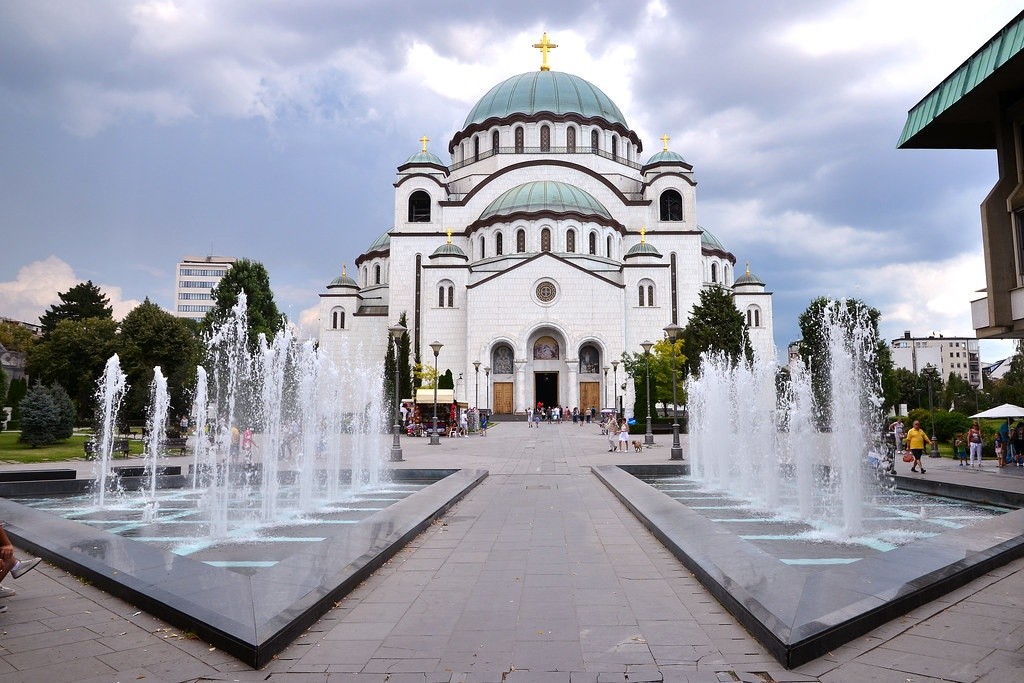 |
| Photo: Fliickr |
Church of Saint Sava is an impressive sight, whether you’re an Orthodox Christian or not, this place is a must. This symbol of Belgrade is without a doubt one of the most amazing buildings in all of Balkans, which is a difficult title to obtain. You’ll see that it’s not only epic in size, but also magnificent as an overall experience.
So, buckle up and get ready to learn a little something about its rich and complex history and also its existence in the former Yugoslavia. You’ll see there’s a reason Vogue Magazine called it Eastern Europe’s Sagrada Família!
The church is dedicated to one of the most fascinating individuals in Serbian history – the founder of the Serbian church.
Sava, born Rastko Nemanjić, was the son of the Serbian župan Stefan Nemanja. His fairytale-like life story is everything but boring. Even though he was destined to lead a life of riches and abundance, Rastko had a different idea in mind.
What’s interesting is that, as a teenager, he gave up his crown and escaped at night to Greece’s Mt. Athos. There he became a monk, decided to live in modesty and accepted a new identity by taking the name Sava. Sava was remembered for dedicating his entire life to the Serbian church and people and their well-being.
Now a little something about what you should expect when you get there. The church’s history is fairly long and turbulent. A lot of ups and downs and complex conditions got the church to the stage that it’s in today – magnificent, but still unfinished.
Fortunately, the exterior was completed in 2004. The church’s facade is covered in smooth white marble and granite and topped with several copper domes.
In case you’ve ever been to Istanbul, you might notice the similarity between this church and Hagia Sophia. Namely, the church is based on its architecture and also the Serbian Gračanica monastery. It’s built in the Serbian-Byzantine style.
The church is in the very center of Belgrade, on the Vračar plateau. You should know that the spot the church’s in isn’t just a random location where they found enough space for such a grand building. There’s actually a lot of meaning behind it.
To put it briefly, Serbia was under Turkish rule for around five centuries, during which Serbian people constantly tried to resist the occupation. In 1595, after an uprising in northern Serbia, Turkish grand vizier Koca Sinan Pasha decided to send a message to the Serbian people. As an act of cruelty, he asked for St. Sava’s relics to be transported to Belgrade from the Mileševa monastery. Then, he publicly burned them at the same spot where the church is located now. That brings even more meaning and sentimentality for Serbian Orthodox Christians.
4. Tikal (Temple IV)
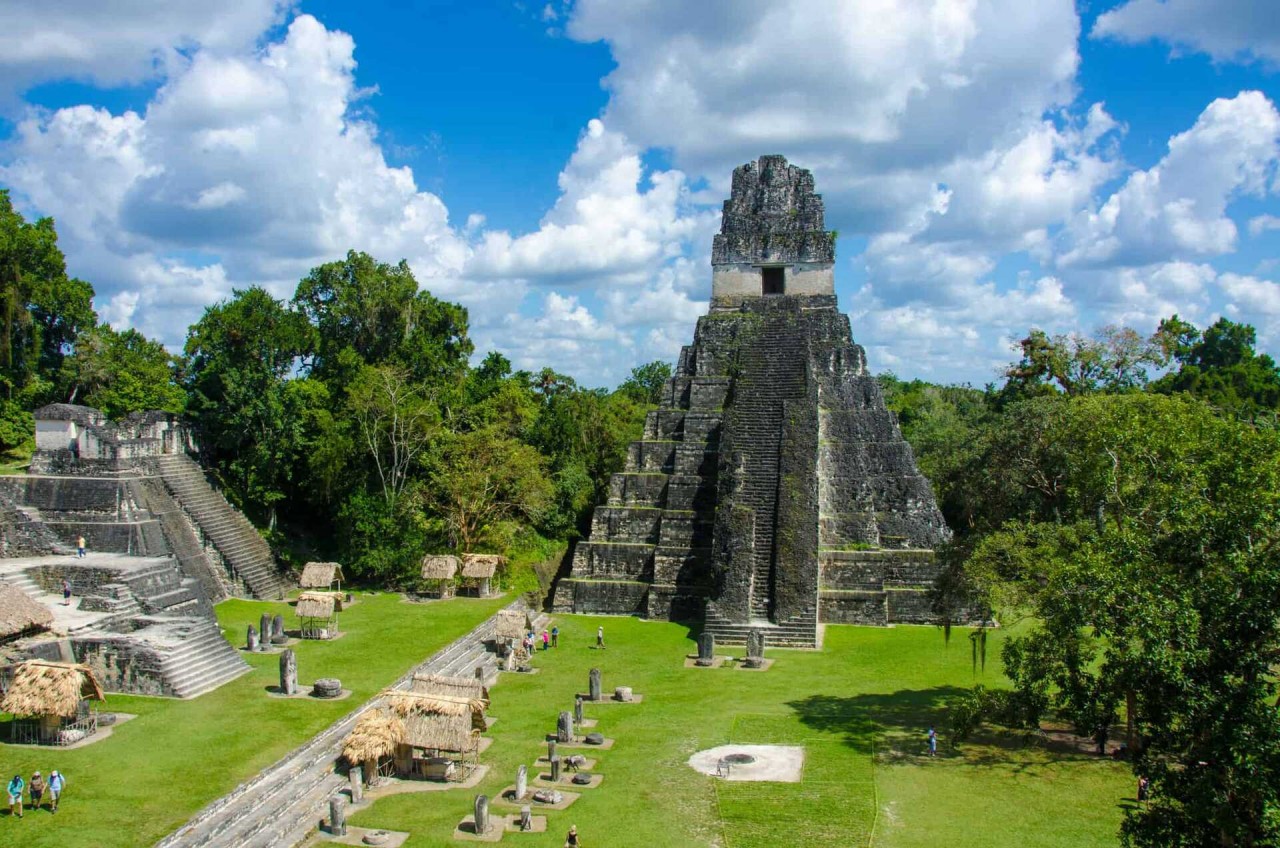 |
| Photo: Odyssey Traveller |
Tikal Temple IV is a Mesoamerican pyramid in the ruins of the ancient Maya city of Tikal in modern Guatemala. It was one of the tallest and most voluminous buildings in the Maya world. The pyramid was built around 741 AD. Temple IV is located at the western edge of the site core. Two causeways meet at the temple; the Tozzer Causeway runs east to the Great Plaza, while the Maudslay Causeway runs northeast to the Northern Zone. Temple IV is the second tallest pre-Columbian structure still standing in the New World, just after the Great Pyramid of Toniná in Chiapas, Mexico, although Teotihuacan's Pyramid of the Sun may once have been taller.
The pyramid was built to mark the reign of the 27th king of the Tikal dynasty, Yik'in Chan K'awiil, although it may have been built after his death as his funerary temple. Archaeologists believe that Yik'in Chan K'awiil's tomb lies undiscovered somewhere underneath the temple. The summit shrine faces eastward to the site core, with Temple III visible directly in front and Temple I and Temple II beyond it.
5. Jetavanaramaya
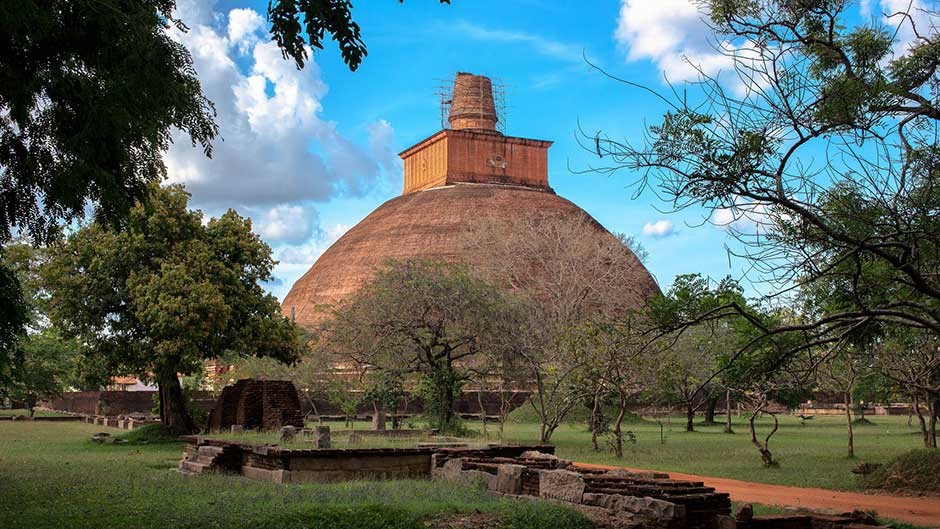 |
| Photo: The Miracle Island |
The Jetavanarama stupa or Jetavanaramaya is a stupa, or Buddhist reliquary monument, located in the ruins of Jetavana monastery in the UNESCO world heritage city of Anuradhapura, Sri Lanka. At 122 metres (400 ft), and was the world's tallest stupa; and the third tallest structure in the world when it was built by King Mahasena of Anuradhapura (273–301). He initiated the construction of the stupa: 49 following the destruction of the Mahaviharaya of Anuradhapura. His son Maghavanna I completed the construction of the stupa, and was renovated by Parakramabahu I of Polonnaruwa. A part of a sash or belt tied by the Buddha is believed to be the relic that is enshrined here.
The structure is significant in the island's history as it represents the tensions within the Theravada and Mahayana sects of Buddhism; it is also significant in recorded history as one of the tallest structures in the ancient world, and the tallest non-pyramidal building; the height of the stupa was 122 metres (400 ft), making it the tallest stupa in the ancient world. With the destruction and abandonment of Anuradhapura kingdom in the 11th century, the stupa with others was covered by jungle. King Parakramabahu in 12th century tried to renovate this stupa and it was rebuilt to the current height, a reduction from the original height. Today it stands at 71 metres (233 ft).
The compound covers approximately 5.6 hectares and is estimated to have housed 10,000 Buddhist monks. One side of the stupa is 176 m (576 ft) long, and the flights of stairs at each of the four sides of it are 9 m (28 ft) wide. The doorpost to the shrine, which is situated in the courtyard, is 8 m (27 ft) high. The stupa has a 8.5 m (28 ft) deep foundation, and sits on bedrock.
The structure is no longer the tallest, but it is still the largest, with a base-area of 233,000 m2 (2,508,000 sq ft). Approximately 93.3 million baked bricks were used in its construction; the engineering ingenuity behind the construction of the structure is a significant development in the history of the island.
6. Sri Ranganathaswamy
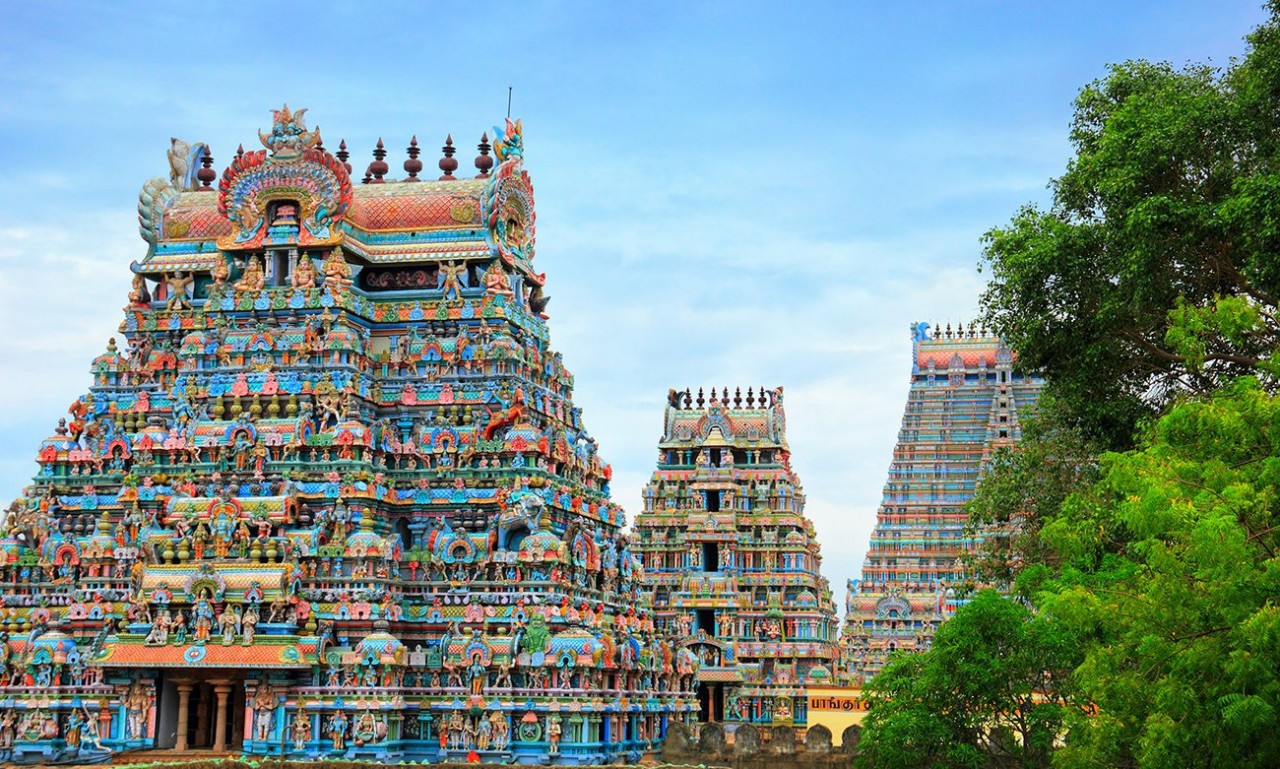 |
| Photo: Ramyas Hotels Trichy |
The Sri Ranganathaswamy Temple is a Hindu temple dedicated to Ranganatha, a form of the Supreme God, Maha Vishnu, located in Srirangam, Tiruchirapalli, Tamil Nadu, India. Constructed in the Dravidian architectural style, the temple is glorified by Alvars in their Divya Prabhanda[5] and has the unique distinction of being the foremost among the 108 Divya Desams dedicated to The Supreme God Vishnu.
It is the most illustrious Vaishnava temples in South India rich in legend and history. The temple has played an important role in Vaishnavism history starting with the 11th-century career of Ramanuja and his predecessors Nathamuni and Yamunacharya in Srirangam. Its location, on an island between the Kollidam and Kaveri rivers, has rendered it vulnerable to flooding as well as the rampaging of invading armies which repeatedly commandeered the site for military encampment. The temple was looted and destroyed by the Delhi Sultanate armies in a broad plunder raid on various cities of the Pandyan kingdom in early 14th century. The temple was rebuilt in late 14th century, the site fortified and expanded with many more Gopurams in the 16th and 17th centuries. It was one of the hubs of early Bhakti movement with a devotional singing and dance tradition, but this tradition stopped during the 14th century and was revived in a limited way much later.
The temple occupies an area of 155 acres (63 ha) with 81 shrines, 21 towers, 39 pavilions, and many water tanks integrated into the complex making it the world's largest functioning Hindu temple. The temple town is a significant archaeological and epigraphical site, providing a historic window into the early and mid medieval South Indian society and culture. Numerous inscriptions suggest that this Hindu temple served not only as a spiritual center, but also a major economic and charitable institution that operated education and hospital facilities, ran a free kitchen, and financed regional infrastructure projects from the gifts and donations it received.
7. Akshardham Temple
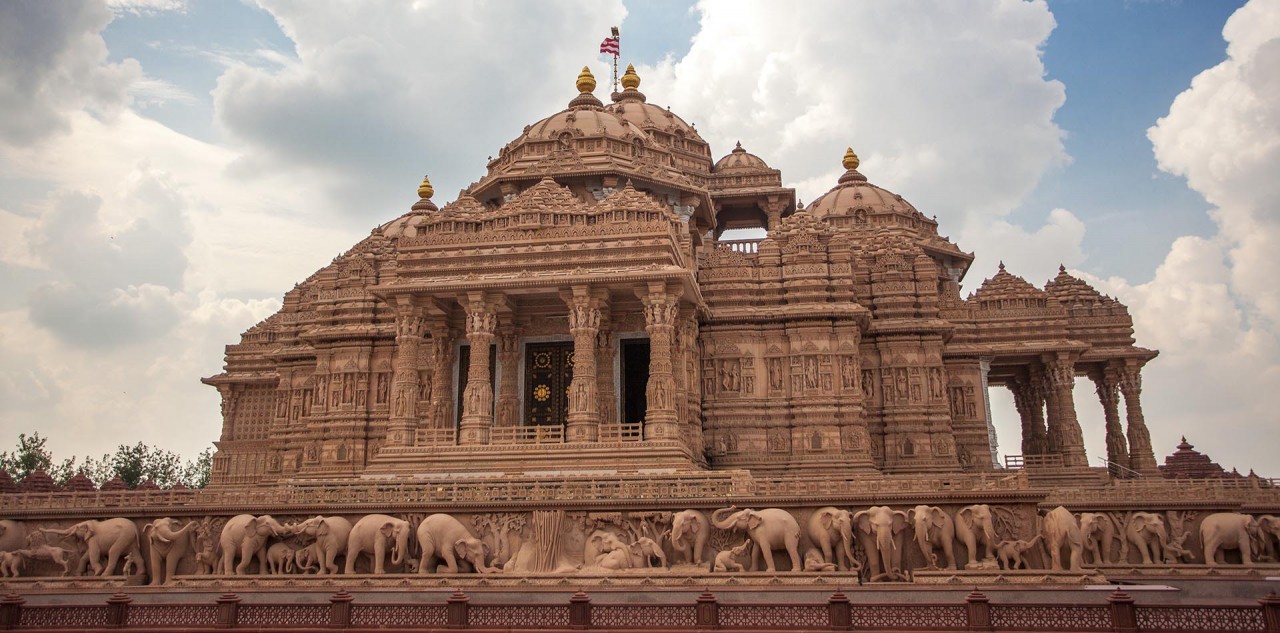 |
| Photo: Akshardham |
Akshardham Temple is a spiritual complex nestled in New Delhi and is a popular Hindu temple of Delhi. This marvelous temple was constructed in the year 2005 at Noida Mor region of New Delhi and is referred as Akshardham Temple of Swaminarayam Akshardham. The term Akshardham is the combination of two words ‘Akshar’ means ‘eternal’ and ‘Dham’ means ‘abode’. On a whole it actually means the abode of eternal values, virtues and principles which are mentioned in Vedas and Puranas of Hindu mythology.
Apart from all this, the complex of Akshardham Temple in Delhi displays numerous traditional aspects, beautiful architecture, Indian culture and spirituality. In the centre the main complex is built on the principles of Vastu Shastra and Pancharatra Shashtra which is called as Akshardham Mandir. Akshardham Temple of Delhi is one of the prime attractions in Delhi where one can witness exclusive architectural charm with more than 234 beautifully carved pillars, 9 elaborate domes, 20 quadrangle spires and 20000 sculptures of spiritual personalities from India. It is one of the major attractions for history buffs and art lovers as one can here easily enjoy intricate art and flawless craftsmanship. Moreover, the whole temple is build using Italian Carrara marble and pink sandstone.
8. Borobudur
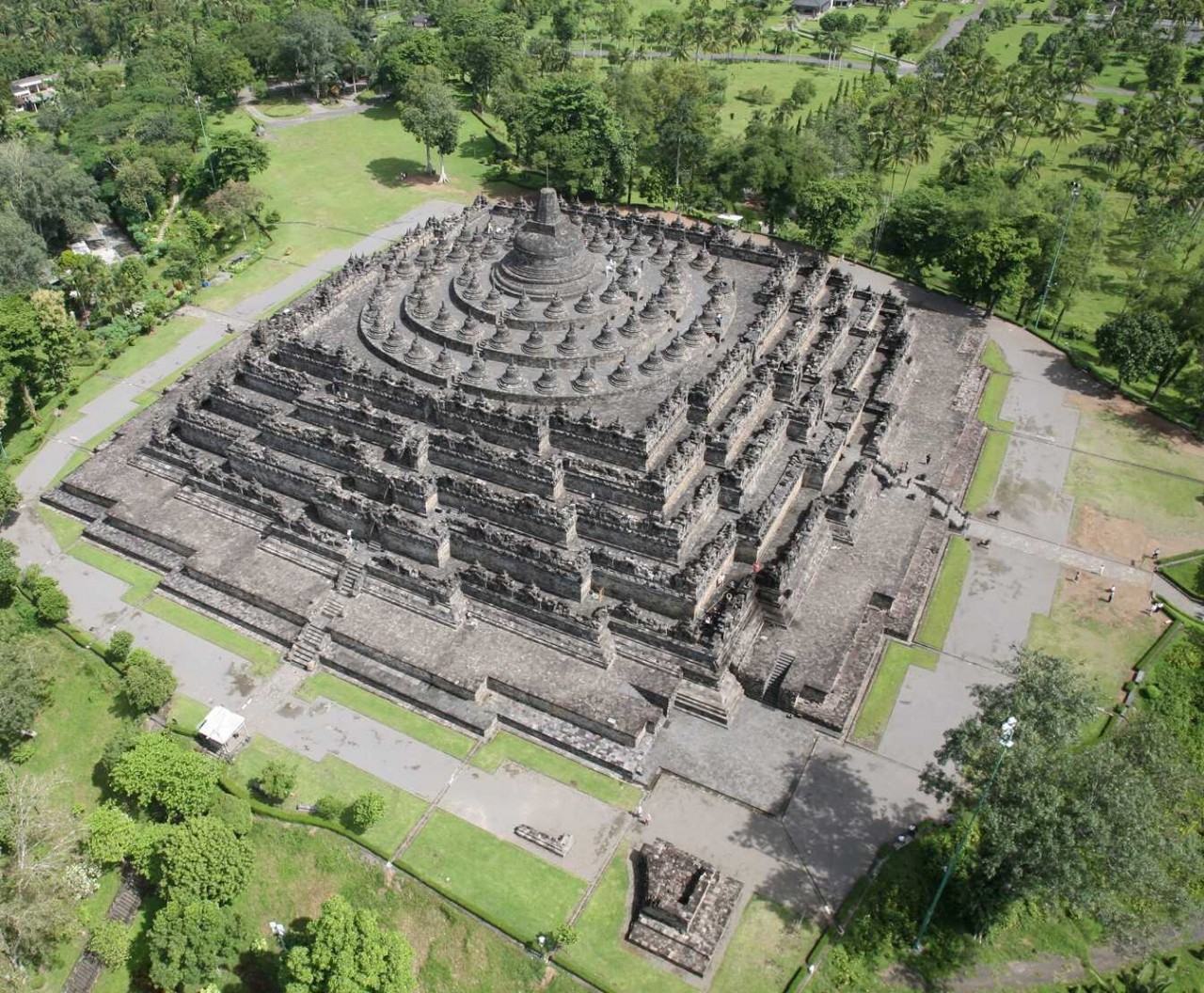 |
| Photo: Best Indonesia Travel Destination |
Located on the island of Java, the magnificent Borobudur temple is the world's biggest Buddhist monument. The temple sits majestically on a hilltop overlooking lush green fields and distant hills. Built between AD 780 and 840 during the reign of Syailendra dynasty, the temple's design in Gupta architecture reflects India's influence on the region. However, there are enough indigenous scenes and elements incorporated to make Borobudur uniquely Indonesian.
It covers a total surface area of around 2,500 m2. The monument is a marvel of design, decorated with 2,672 relief panels and originally 504 Buddha statues. The architecture and stonework of this temple have no equal. It was built without using any cement or mortar! The structure is like a set of massive interlocking Lego blocks held together without any glue.
The temple has remained strong even through ten centuries of neglect. It was rediscovered in 1814 under the order of Sir Thomas Stanford Raffles. In the 1970s, the Indonesian Government and UNESCO worked together to restore Borobudur to its former majesty. The restoration took eight years to complete, making Borobudur one of Indonesia’s most valuable treasures.
9. Karnak (Great Hypostyle Hall)
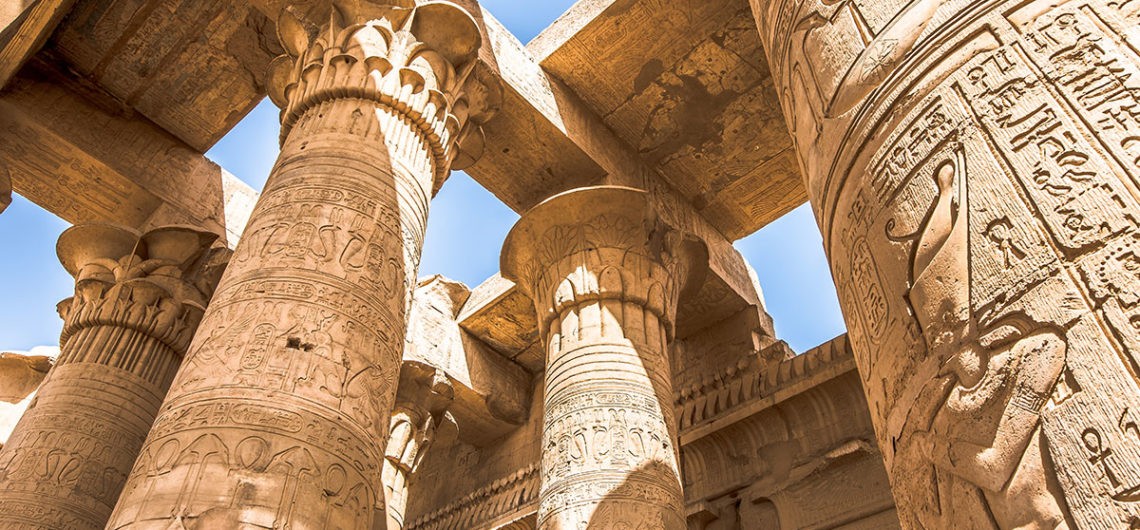 |
| Photo: Hurghada Excursions |
Have you ever stepped into a church and been awed by its architecture? That's how ancient people must have felt if they were among the few to enter the Great Hypostyle Hall at Karnak.
The Great Hypostyle Hall was part of one of the largest religious complexes in the ancient world, located in Egypt in Thebes (today, the city of Luxor). The Great Hypostyle Hall was built by Pharaoh Seti I beginning around 1250 BC. Some decorations on the structure were finished during the reign of his son, Ramesses II. The hall was located between two gateway structures known as pylons that had been built earlier.
Before we get to specifics about the structure, let's cover an architectural definition. A hypostyle is a large interior space with a flat roof supported by columns. The word comes from ancient Greek and it means 'under pillars.' In places like ancient Egypt and Persia, hypostyles were a way to create large inner spaces before the invention of more advanced roof systems like vaulted ceilings and arches. But all the columns meant a hypostyle wasn't an open space. Instead, it was like a forest of stone columns. Often, they were decorated with images or symbols related to the building's purpose or the ruler who built it.
Today the Great Hypostyle Hall in Karnak is an archaeological site. It isn't in great shape, and some parts have fallen down. But enough still stands to create a sense of awe at what must have been an imposing space.
The Great Hypostyle Hall was dominated by sandstone columns. On both sides of a central hall, round columns supported two large roof sections.
Then, lining the central hall were 12 higher, larger columns that allowed sections of vertical wall between them to contain slotted stone openings called clerestory windows. These narrow windows were the only way to allow some light into the interior. But it wouldn't have been very bright and must have created a sense of mystery in the mostly dark space. The central hall also led to the innermost room of the temple, a sanctum that served as the home of the god Amun-Ra.
The columns supported a network of large stone horizontal beams called architraves. Four sets of architraves sat over the large columns in the center, and they ran east to west. On the sides, where the lower roof sections were located, the architraves ran north to south. The architraves then supported the actual flat roof structure.
10. Angkor Wat Temple
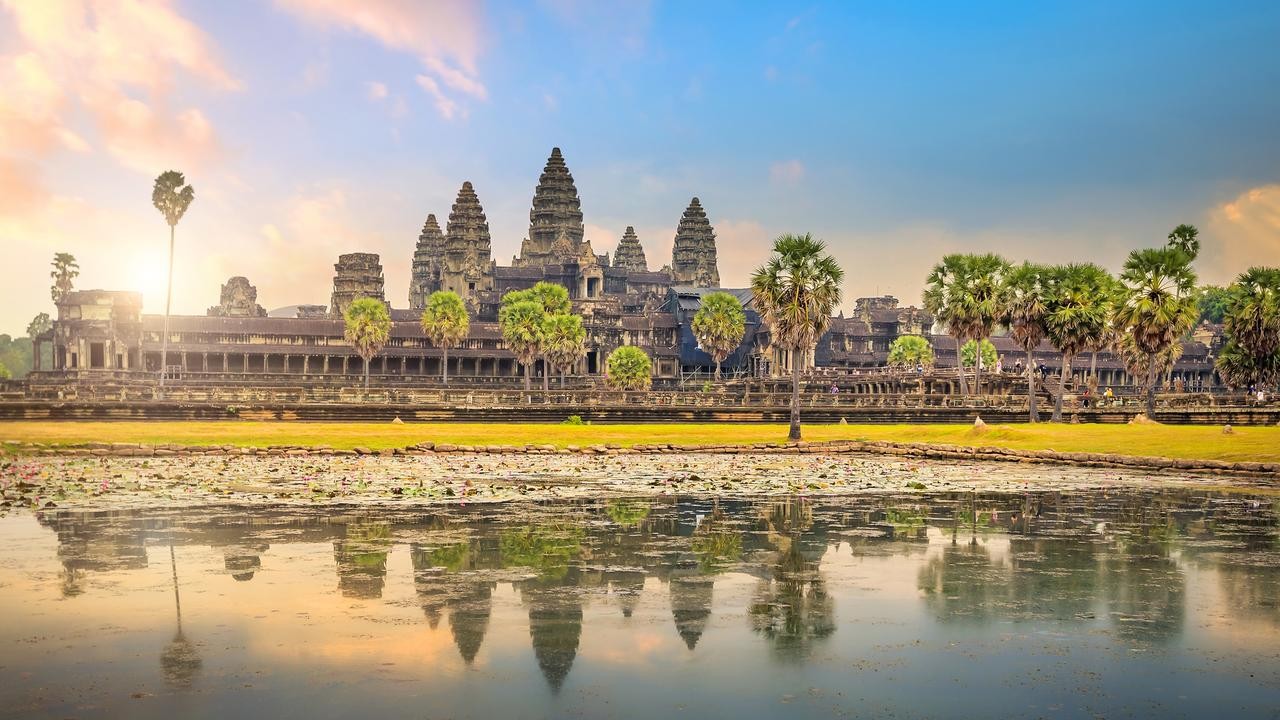 |
| Photo: Wikipedia |
Angkor Wat is an enormous Buddhist temple complex located in northern Cambodia. It was originally built in the first half of the 12th century as a Hindu temple. Spread across more than 400 acres, Angkor Wat is said to be the largest religious monument in the world. Its name, which translates to “temple city” in the Khmer language of the region, references the fact it was built by Emperor Suryavarman II, who ruled the region from 1113 to 1150, as the state temple and political center of his empire.
Originally dedicated to the Hindu god Vishnu, Angkor Wat became a Buddhist temple by the end of the 12th century.
Although it is no longer an active temple, it serves as an important tourist attraction in Cambodia, despite the fact it sustained significant damage during the autocratic rule of the Khmer Rouge regime in the 1970s and in earlier regional conflicts.
Although Angkor Wat was no longer a site of political, cultural or commercial significance by the 13th century, it remained an important monument for the Buddhist religion into the 1800s.
Indeed, unlike many historical sites, Angkor Wat was never truly abandoned. Rather, it fell gradually into disuse and disrepair.
Nonetheless, it remained an architectural marvel unlike anything else. It was “rediscovered” in 1840s by the French explorer Henri Mouhot, who wrote that the site was “grander than anything left to us by Greece or Rome.”
The compliment can likely be attributed to the temple’s design, which is supposed to represent Mount Meru, the home of the gods, according to tenets of both the Hindu and Buddhist faiths. Its five towers are intended to recreate the five peaks of Mount Meru, while the walls and moat below honor the surrounding mountain ranges and the sea.
Unfortunately, although Angkor Wat remained in use until fairly recently—into the 1800s—the site has sustained significant damage, from forest overgrowth to earthquakes to war.
The French, who ruled what is now known as Cambodia for much of the 20th century, established a commission to restore the site for tourism purposes in the early 1900s. This group also oversaw ongoing archeological projects there.
While restoration work was accomplished in bits and pieces under French rule, major efforts didn’t begin in earnest until the 1960s. By then, Cambodia was a country transitioning from colonial rule to a limited form of constitutional monarchy.
When Cambodia fell into a brutal civil war in the 1970s, Angkor Wat, somewhat miraculously, sustained relatively minimal damage. The autocratic and barbarous Khmer Rouge regime did battle troops from neighboring Vietnam in the area near the ancient city, and there are bullet holes marking its outer walls as a result.
Since then, with the Cambodian government undergoing numerous changes, the international community, including representatives of India, Germany and France, among others, have contributed to the ongoing restoration efforts.
The site remains an important source of national pride for Cambodians.
In 1992, it was named a UNESCO World Heritage site. Although visitors to Angkor Wat numbered in just the few thousands at the time, the landmark now welcomes some 500,000 visitors each year—many of whom arrive early in the morning to capture images of the sunrise over what still is a very magical, spiritual place.
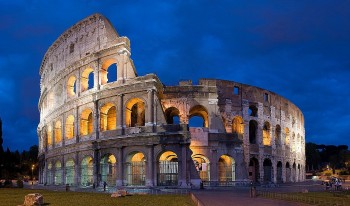 | 11 Insteresting Facts About Italy That You Probably Do Not Know Italy is full of wonderful things, places and iconic plates for first time visitors, but how much do you actually know about this country? Let's ... |
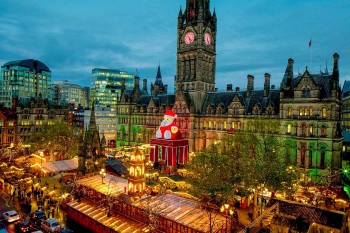 | Top 10 Best Christmas Markets in Europe Christmas is the best time in the year for relaxation and fun with your loved ones. Dont forget to visit these biggest and best Christmas ... |
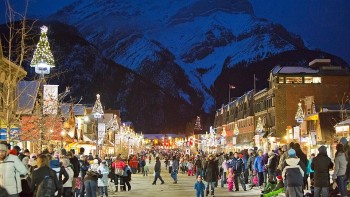 | Top 10 Most Idyllic Places To Celebrate Christmas In Canada If you are looking to celebrate your Christmas somewhere else outside the country, then Canada can be the perfect choice for you with these 10 ... |
Recommended
 World
World
India strikes back at terrorists with Operation Sindoor
 World
World
India sending Holy Relics of Lord Buddha to Vietnam a special gesture, has generated tremendous spiritual faith: Kiren Rijiju
 World
World
Why the India-US Sonobuoy Co-Production Agreement Matters
 World
World
Vietnam’s 50-year Reunification Celebration Garners Argentine Press’s Attention
Popular article
 World
World
"Will continue offering our full support to Indian govt": US FBI Director after Pahalgam attack
 World
World
"Great Leader": JD Vance Lauds PM Modi During His India Visit
 World
World
Trump’s Tariff Pause: A Strategic Move from “The Art of the Deal”?
 World
World





